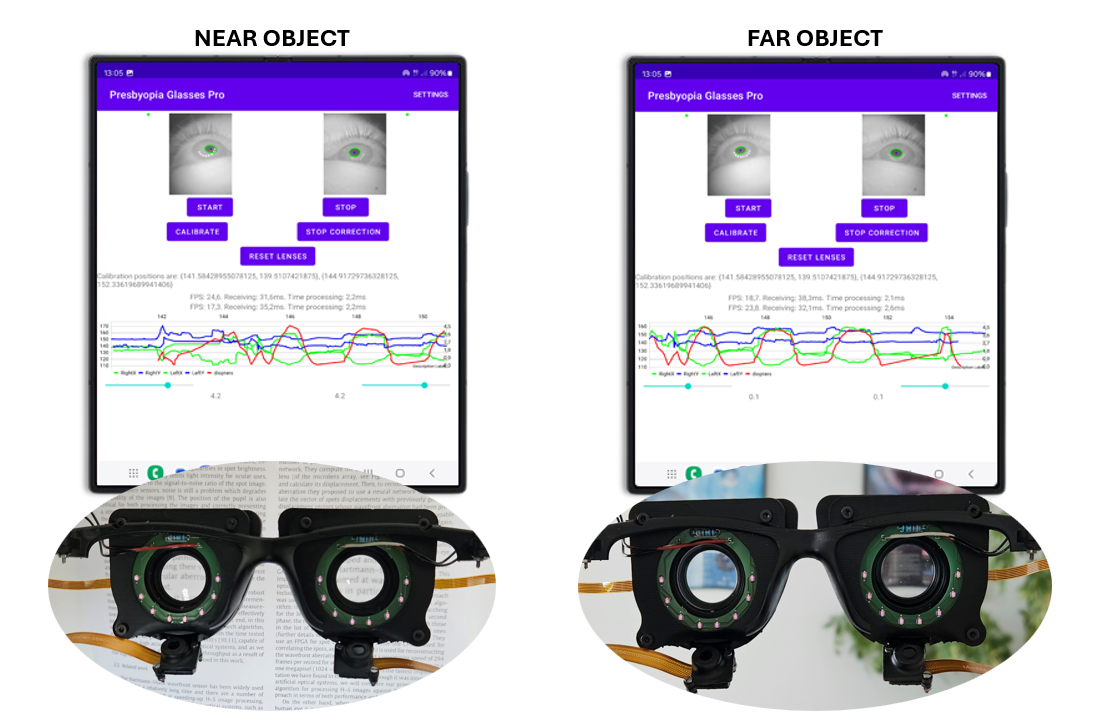Research
Prototypes
I focus on developing advanced prototypes that combine human visual optics and computer science. I am particularly interested in designing optimal algorithms and systems for specific application scenarios.
Some prototypes I have been involved in:
(1) Automatic Presbyopia Correction Glasses prototype for correcting presbyopia using a focus tunable lens and a custom-designed algorithm to automatically adjust the focus based on the user's eyes vergence.
(2) Pupil Tracking Glassses prototype for tracking the pupil of the eye using a custom-designed algorithm to adjust the focus of the lens based on the user's gaze direction.
(3) Ultra-wide Peripheral Refractor (UPER) prototype for measuring peripheral refraction across a wide retinal area using a scanning laser and wavefront sensor.
Related technologies:
Optics: Adaptive optics, tunable lenses, wavefront sensing;
Electronics: Embedded systems, microcontrollers, custom PCB design;
Software: Real-time image processing, computer vision, control algorithms.

Machine learning: method & application
My research in machine learning is driven by the need to address real-world challenges in biomedical imaging and optics. I focus on developing robust, efficient, and interpretable models that can process complex datasets, extract meaningful features, and provide actionable insights for scientific and medical applications. By leveraging both traditional and deep learning techniques, I aim to automate tasks such as image segmentation, object detection, and pattern recognition, enabling faster and more accurate analysis. My work also involves optimizing algorithms for deployment on resource-constrained devices, ensuring accessibility and scalability in practical scenarios.
The techniques developed included the
(1) DeepPT a deep-learning-based pupil tracking algorithm for obtaining the pupil center and diameter in real-time, also in low-end devices. This model allows fast, efficient and accurate pupil tracking over complex scenarios
(2) DeepGaze a deep-learning-based gaze distance estimation algorithm for estimating the distance between the user and the object in real-time, also in low-end devices. This model allows fast, efficient and accurate accomodation correction for presbyopic subjects over complex scenarios
Related technologies:
Traditional ML: Regression, classification, clustering, feature extraction, image processing.
Deep learning: Neural networks, CNNs, real-time inference, transfer learning, custom model deployment.

Acceleration, High Performance Computing and Embedded Systems
My work in acceleration, GPU programming, high performance computing (HPC), and embedded systems focuses on optimizing computationally intensive tasks for scientific and industrial applications. I develop efficient algorithms and leverage parallel computing architectures—such as GPUs and FPGAs—to significantly speed up data processing, simulation, and analysis. Additionally, I design embedded solutions for real-time processing and deployment in resource-constrained environments.
The techniques developed include
(1) VolRec 4D a OCT algorithm to reconstruct 4D volumes in high resolution from low resolution volumes, achieving real-time processing and reconstruction of large volumes.
(2) cuElSe a GPU-accelerated algorithm for real-time pupil tracking and gaze estimation, achieving high accuracy and low latency in real-time applications over GPU paradigm.
(3) cuExCuSe a GPU-accelerated algorithm for real-time pupil tracking and gaze estimation, achieving high accuracy and low latency in real-time applications over GPU paradigm.